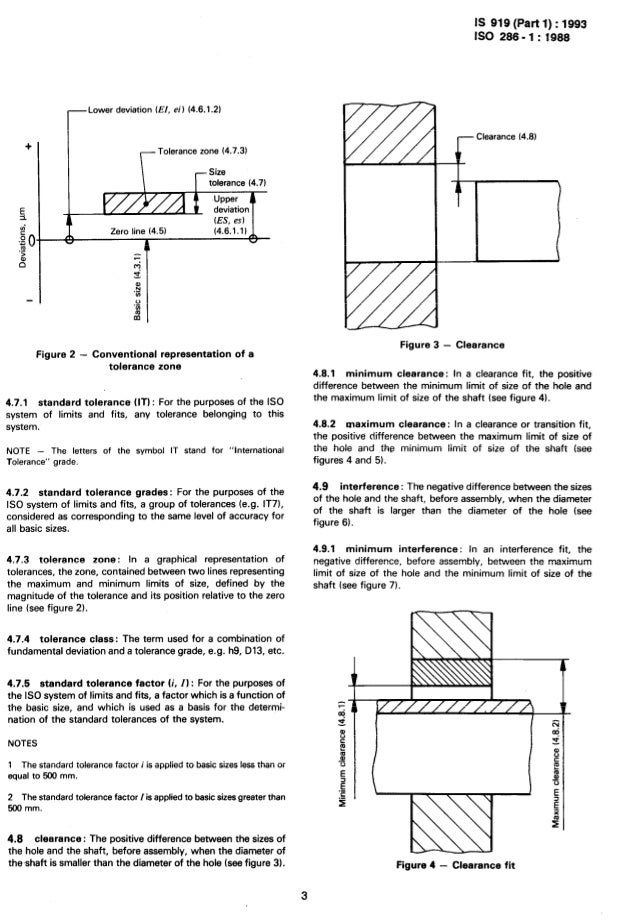
Nominal hole sizes (mm) over 3. Annex - Graphical review of tolerance zones of holes and shafts. Cfadisk usb driver x64. Tolerance systems will be useful with regard to the application IS0 2768-1, General tolerances for dimensions without. EF4 F4 FG4 G4 H4 JS4 K4 M4 N4 P4 R4 s4.
Grade NOMINAL HOLE SIZES (mm) over 3 6 10 18 30 40 50 65 80 100 120 140 160 180 200 225 250 280 315 355 inc.
Thread standards Tapping tools are manufactured in five different standard: ISO, ANSI, DIN, DIN/ANSI and JIS. DIN and ISO are common world-wide, ANSI is most common in American markets and JIS is most common in Asia markets. • ISO, ANSI and JIS have quite short OAL (overall length) and are rather similar, except for the shank diameter which is in inch for ANSI and metric for ISO and JIS • DIN is a long version, with metric shank diameter and long OAL • DIN/ANSI is a mix of both, with ANSI shank diameter and OAL from DIN. ISO shank and square dimensions Shank diameter (DMM),mm Square (WSC), mm ISO 529 Metric ISO 529 UNC/UNF BSW/BSF ISO2283 Metric ISO2284 G ISO2284 Rc 2.50 2.00 M1 M1.2 M1.4 M1.6 No. 0 M1.8 M2 No. 1 2.80 2.24 M2.2 No.
2 M2.5 No. 3 3.15 2.50 M3 No. 5 M3 3.55 2.80 M3.5 No. 6 M3.5 M4 4.00 3.15 M4 M5 4.50 3.55 M4.5 No. 8 M6 5.00 4.00 M5 No.
10 3/16 5.60 4.50 M5.5 No. 12 7/32 M7 6.30 5.0 M6 1/4 M8 7.10 5.60 M7 9/32 8.00 6.30 M8 5/16 M10 G1/8 Rc 1/8 9.00 7.10 M9 M12 10.00 8.00 M10 3/8 G1/4 Rc1/4 8.00 6.30 M11 7/16 9.00 7.10 M12 1/2 11.20 9.00 M14 9/16 M14 12.50 10.00 M16 5/8 M16 G3/8 Rc3/8 14.00 11.20 M18 M20 11/16 3/4 M18 M20 16.00 12.50 M22 7/8 M22 18.00 14.00 M24 1” M24 G5/8 Rc5/8 20.00 16.00 M27 M30 1 1/8 M27 M30 G3/4 Rc3/4 22.40 18.00 M33 1 1/4 G7/8 Rc7/8 25.00 20.00 M36 1 3/8 G1” Rc1” 28.00 22.40 M39 M42 1 1/2 . ANSI shank and square dimensions Shank diameter (DMM), inch Square (WSC), inch ASME B94.9 machine screw sizes ASME B94.9 fract.
Sizes ASME B94.9 metric sizes 0.141 0.11 No. 0 M1.6 No. 3 M2.5 No. 6 M3.5 0.168 0.131 No. 8 M4 0.194 0.152 No.
10 M5 0.220 0.165 No. Normal tap tolerance is ISO 2 (6H), which generates an average quality fit between screw and nut. Lower tolerance (ISO 1) generates a fine fit without a gap on the flanks between screw and nut. Higher tolerance (ISO 3) generates a rough fit with a large gap. This is used if the nut is coated, or if a loose fit is preferred. Between tolerances 6H (ISO2) and 6G (ISO3), and between 6G and 7G, there are also taps with tolerance 6HX and 6GX. “X” means the tolerance is outside the standard and is used for taps working with high strength or abrasive materials such as cast iron.
These materials do not cause oversize problems so higher tolerance can be used in order to increase tool life. The tolerance width is equal between 6H and 6HX. Forming taps are usually produced with a 6HX or 6GX tolerance. Pipe threads refer to the following standards: • G threads to ISO 228-1. One class for internal thread (tap) • Rc and Rp threads to ISO 7-1 • NPT and NPSM to ANSI B1.20.1 • NPTF and NPSF to ANSI B1.20.3 Tolerance positioning The tolerance width on a tap designed for a specific tolerance is much smaller than the tolerance width on the finished thread.
The tap tolerance is positioned so that the tap cuts a correct thread from the start. When the tap is used, it wears gradually and will eventually be too small to cut a thread correctly, having become smaller than the lower tolerance of the GO gauge.
The optimum situation would be to position the tap tolerance at the upper part of the internal thread area, but then there is a risk that the tap cuts an oversized thread, above the upper limit of the NO-GO gauge. Taps with an “X” tolerance, used for materials that do not cause oversize problems, are positioned higher. The result is a longer tool life because more wear can occur before the tap cuts a too small thread. Sandvik Coromant Part of global industrial engineering group Sandvik, Sandvik Coromant is at the forefront of manufacturing tools, machining solutions and knowledge that drive industry standards and innovations demanded by the metalworking industry now and into the next industrial era. Educational support, extensive R&D investment and strong customer partnerships ensure the development of machining technologies that change, lead and drive the future of manufacturing. Sandvik Coromant owns over 3,100 patents worldwide, employs over 7,900 staff, and is represented in 150 countries.